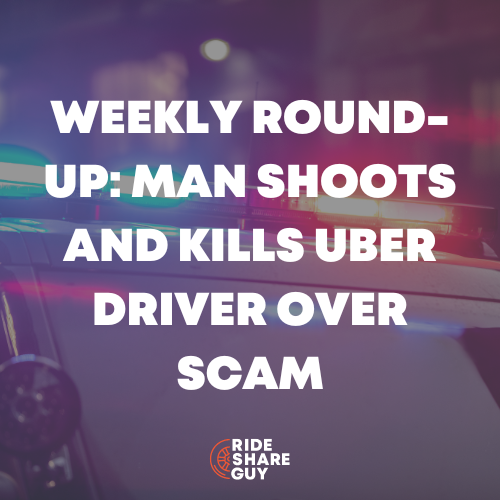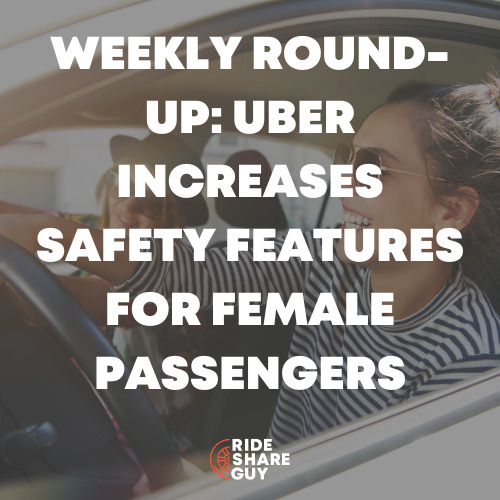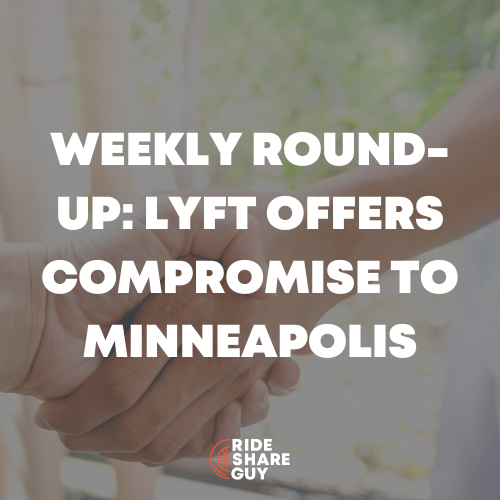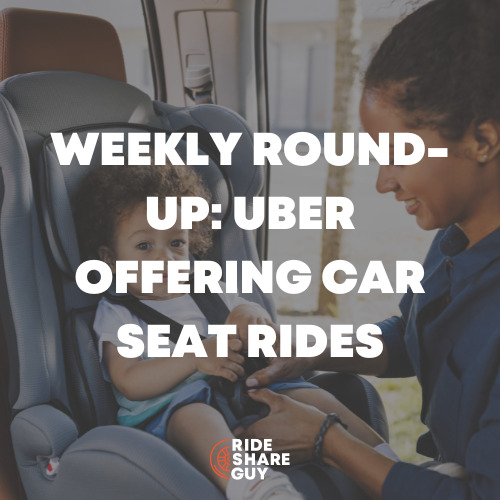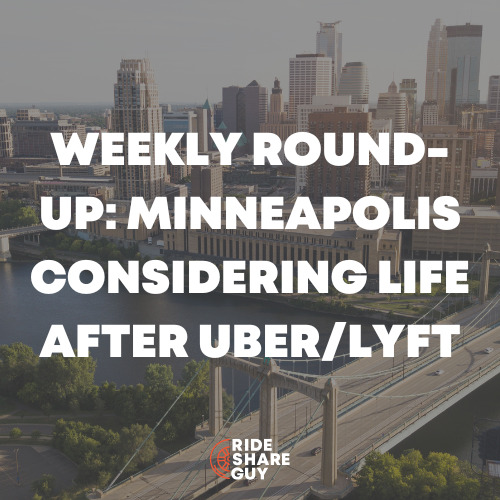Uber and Lyft are taking turns in major Driver announcements. A few months ago I had the pleasure of meeting a lot of executives, including the CEO, of Uber during their Driver announcement in Los Angeles.
I am glad both companies are listening to our SMTMC community and making some much needed changes regarding Safety, Unjust Deactivations, Transparency etc.
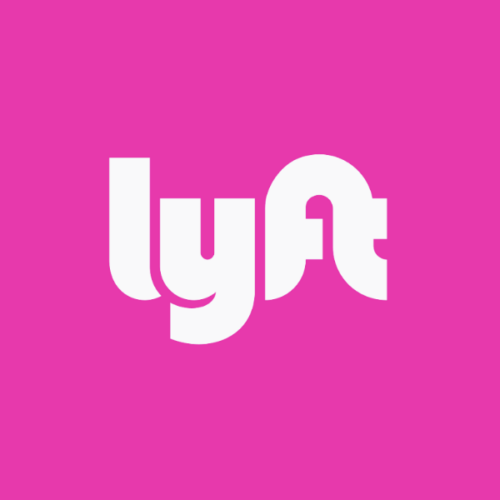
Now it is Lyft’s Turn! There is a lot to unpack in this package announced today. I will have my take at the end of each important segment.
Throughout the year, Lyft spends time listening to their customers (Passengers & Drivers) and working on solutions to make their lives better.
Lyft packages these improvements into releases that bring together their most meaningful product updates, and for drivers, Lyft’s Early 2024 Release is the biggest one yet.
Pay attention to the word “Early”, I expect more to come from Lyft in 2024!
Today’s release features important improvements (read my take) to earnings, deactivations, and safety, led by a new pay standard. I will break down each segment for our Newsletter readers as well as what I personally think of these changes!
Summary & Breakdown of Lyft’s Early 2024 Release
New driver benefits in the Early 2024 Release:
- Earn 70% of rider fares after external fees, Guaranteed
- See where every dollar of riders’ fares go
- Earn more for waiting during scheduled rides
- Find more ways to choose rides at the airport
- Access new earning and navigation opportunities for EVs
- Appeal deactivations easily in the Lyft app
Make sure you tune into today’s SMTMC Episode at 3 PM PST / 6 PM EST to discuss if Lyft’s New Driver Benefits Will ACTUALLY Benefit Drivers!
Your share of the fare, Guaranteed
Lyft is introducing a new pay standard, the first of its kind in the rideshare industry. According to Lyft, last year, on average, drivers earned roughly 88% of rider payments, after external fees like the extra insurance provided while driving on the platform. But an average isn’t the full story for every driver. In any given week last year, approximately 15 out of 100 drivers earned less than 70% of what riders paid, after external fees. Almost two-thirds of drivers had it happen to them at least once.
Lyft’s new commitment is that drivers will earn 70% or more of rider payments each week, after external fees. Guaranteed. According to Lyft, it is a rock-solid floor: as a driver, if you’re ever under 70% at the end of the week, you’ll be paid the difference as a top-off adjustment.
My Take
I have been at best a skeptic of TNCs if not a harsh critic for the past 8 years. I have not tested this yet since this is just being rolled out nationwide. This certainly protects the 15% of the drivers from earning less than 70% after Lyft’s external fees (explained below) going forward but what about the remaining 85%? Are they going to see an increase in their personal Take Rate? I don’t think this is another Rate cut but it sure looks like 85% of drivers who earn at least 88% of the Rider fare after external fees possibly could be subsidizing the 15% who consistently earned less than 70% of Rider fares after deducting the external fees.
I will test this myself after I do some trips before and after this realignment, should be fairly easy to prove. The skeptic in me says this will be another reduction in Earnings for the majority of drivers but I will hold judgment until I conclude the test and report to you all in another article!
Transparency, see where every dollar of Riders’ Fare goes
Lyft knows that many drivers feel like they can’t trace the path between what a rider pays, what Lyft takes, and what they earn. Or, in other words, how is the rider fare split? Beginning today, drivers on Lyft can see how each rider’s payments are split between drivers, Lyft, and external fees. And a new earnings summary in the Lyft app, redesigned with a focus on transparency, will show drivers a breakdown of where every cent of the rider fare goes.
External fees include government taxes, airport and venue fees, platform expenses and commercial auto insurance that provides coverage beyond regular auto insurance as mandated under most state regulations. These fees vary significantly depending on state and city. Last year, 24% of rider fares went toward these costs on average, with the majority going towards commercial auto insurance. While Lyft is working hard to reduce external fees so drivers can earn more, helping drivers better understand them is an important first step.
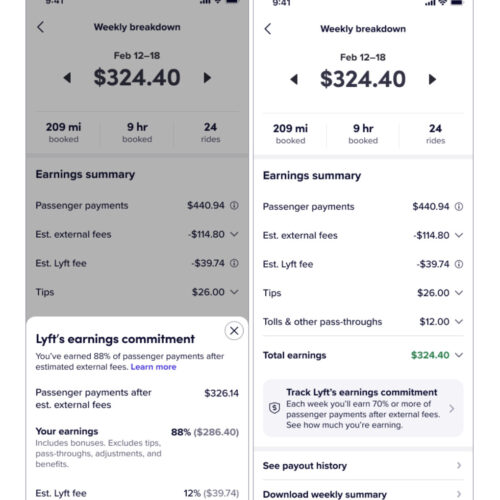
My Take
The Take Rate has been the most hotly debated subject in the driver community for the past few years. We have done many videos on our Youtube channel regarding this issue. Now Each of us will be able to figure out our individual Take Rate after external fees (24%) on our weekly summary. I think transparency has been absent on many issues for a decade, I commend Lyft on taking this first step. Uber, are you listening? Lyft is finally leading, I suggest Uber follows.
I still think 24% of external fees taken right off the top of Rider fares in aggregate is extremely high for a company like Lyft with a very low asset business model. Time will tell if Lyft will be able to control these external fees, hopefully lower them and share the savings with the driver community!
Earning made easier
In addition to making it clearer where a rider’s fare goes, Lyft is introducing a number of other features to make earning with Lyft easier. Drivers can now:
- Earn more on scheduled rides to compensate them for the time they may spend waiting for a rider at pickup.
- Turn on manual-accept for queued rides to review and choose the ones that work best for them.
- See more ways to find rides at the airport, with clearer guidance in the queue so they can make the most of their time.
- Access new earning opportunities and features for electric vehicles. We’re launching new EV earning incentives in Massachusetts, Oregon, Washington, Nevada, Toronto, and Vancouver. Starting Feb. 12 through July 1, drivers with personal vehicles that give 50 EV rides in a week will earn an extra $100. And in March, we’ll begin rolling out features for EV drivers to opt to only get rides within their battery range, as well as see charging stations and discounts directly on the Lyft map
My Take
I personally like these announcements. Although some specifics are missing like how much per minute drivers will get paid to wait during scheduled trips, it will probably be city specific. The question is how much will the rider pay as in wait fees and what cut will Lyft take out of that, after all it is our time. The rest of them is a nothing burger!
The EV credit/promo being expanded to a few other states outside CA is a major plus. It is definitely better than Uber’s ($1 per trip) at $2 per trip. Will this entice a lot of drivers to invest in expensive EVs to do rideshare? I doubt it since this offer expires on July 1, 2024. I hope both Uber and Lyft extend the EV promo indefinitely, that will be the only way their fleets may be fully electric by 2030 in CA.
Easier driver deactivation appeals
While driver earnings and transparency are at the center of Lyft’s Early 2024 Release, we know that drivers need to feel safe on the Lyft platform to spend time earning on it. Safety is fundamental to the driver and rider experience. According to Lyft, they are focused on balancing the safety of everyone using the platform; occasionally, that requires Lyft to place a temporary hold (suspension) on a driver’s account while they investigate the specific details of that complaint. Lyft hopefully understands these deactivations can be frustrating.
When deactivations happen, Lyft’s goal is for drivers to feel supported and respected throughout a process that is timely, transparent, and fair. To do so, Lyft will launch a streamlined, in-app button for drivers to appeal deactivation decisions. This new channel gives drivers the ability to provide Lyft with any new or updated information as well as direct access to a specialized support team dedicated to deactivation appeals. The feature is already live in Washington State, Portland, Minnesota, and New York State and launches nationally in March.
Lyft’s appeal feature is the latest improvement in the deactivation process. On average, 77% of drivers are reactivated within 24 hours of having a temporary hold applied to their account, a 72% improvement from where Lyft was one year ago.
My Take
I have already shown an example of this feature on SMTMC last week when a driver was deactivated by a fraudulent Rider claim. After the new review process by the Safety team, he was back on the platform in an hour without much disruption to his earnings. This is good, the driver community has been asking for these protections and human intervention for a long time. Uber did a similar change a couple of months ago and I am glad that Lyft is following.
Will innocent drivers still fall through the cracks? Probably but at least all the unjust deactivations will be reviewed by a human as opposed to some cut and paste AI chat bot. As an Active driver we are one of these false claims away from being deactivated and I truly appreciate that Lyft made progress toward transparency. Giving drivers more details on their deactivation status, and timeliness, by creating a specialized team to review deactivation appeals.
Elite mode replacing Platinum Plus
One other thing that’s not in today’s Lyft blog announcement and is of interest to our community is replacement of Platinum Plus with Elite. Unfortunately in many cities the point total to achieve Elite status has been increased!
Today the Lyft Rewards program has three tiers: Silver > Gold > Platinum. Drivers can unlock tiers by accumulating points during busy hours (quantity) and maintaining a minimum driving score (quality), each month.
Elite will be the new top tier of Lyft Rewards (above Platinum) and is designed to reward and recognize Lyft’s top 5% of drivers. When drivers earn Elite, they get access to exclusive rewards and savings during the 1-month qualifying period. They’ll need to continuously earn Elite month over month, to maintain status.
Elite rewards:
- 10% cashback on gas purchases with a Lyft Direct card
- Elite status protection helps top drivers stay on top. Elite drivers can restore their status when they maintain Elite for three consecutive months.
- Early access to scheduled rides gives Elite drivers the chance to reserve high-paying trips in advance.
- Premium airport pickups to save time and stay busier. Elite drivers will get bumped up in the airport queue by 30 minutes, every time.
- 6 location filters (e.g. stay-within-area, destination mode, etc) each day so drivers can enjoy more choice over when and where they drive.
- Plus, all the rewards that come with Platinum, Gold, and Silver tiers.
And, in recognition for being part of the inaugural class of Elite drivers, all drivers with an Elite status on Feb 1 get early access to Glow, Lyft’s new dashboard device, which will improve the pickup experience for both riders and drivers.
My Take
This does not apply to me since I never have cared about higher tiers. However one thing will upset many of you is the constant moving of the goal posts. I have received screenshots of the new requirements as far as points are concerned and they are about 10% higher than the old Platinum Plus. The only difference that I see between the old Platinum Plus and Elite is a higher amount of Cash back on gasoline purchases.
My Overall Impressions
There is a lot of information packed in this Early 2024 Driver announcement. Most of it is what drivers have been asking for a long time such as transparency and unjust deactivation protections. But for as long as I can remember the top complaint of the driver community has been regarding low Earnings. I personally do not see much in this package to calm those nerves down, at least not in the sense of trips paying more in order for driver earnings to increase.
I am hoping that Lyft appreciates what the drivers do for the company and at least announce pay increases for minimum fare trips. I have been on the platform for 8 years. When I first started, minimum fare trips were priced at $2.62. I happily did a lot of those since Ride Challenges were very lucrative. With the reduction and in most cases total elimination of incentives, they are no longer profitable. We are in 2024 and all of us are dealing with the effects of inflation. I guess rideshare drivers are immune to cost of living increases since the minimum fare trips are still being priced at $2.62!
